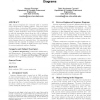6016 search results - page 1096 / 1204 » The semantics of graphical languages |
EDBT
2002
ACM
14 years 10 months ago
2002
ACM
An important issue in data integration is the integration of semantically equivalent but schematically heterogeneous data sources. Declarative mechanisms supporting powerful source...
ICSE
2005
IEEE-ACM
14 years 10 months ago
2005
IEEE-ACM
UML sequence diagrams are commonly used to represent object interactions in software systems. This work considers the problem of extracting UML sequence diagrams from existing cod...
VMCAI
2010
Springer
14 years 7 months ago
2010
Springer
While temporal verification of programs is a topic with a long history, its traditional basis--semantics based on word languages--is illsuited for modular reasoning about procedura...
VMCAI
2010
Springer
14 years 7 months ago
2010
Springer
Tracking subset relations between the contents containers on the heap is fundamental to modeling the semantics of many common programing idioms such as applying a function to a sub...
TLDI
2009
ACM
14 years 7 months ago
2009
ACM
Type-and-effect systems are a natural approach for statically reasoning about a program’s execution. They have been used to track a variety of computational effects, for example...

